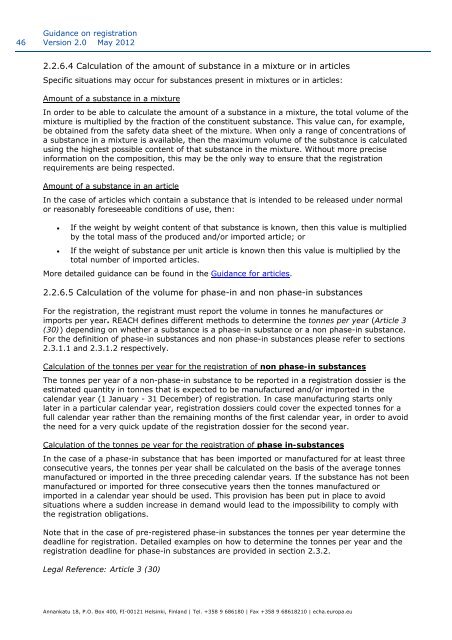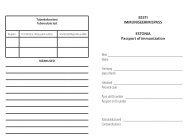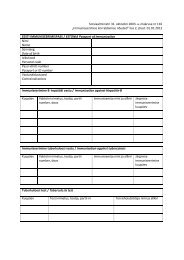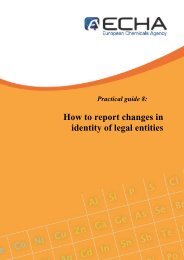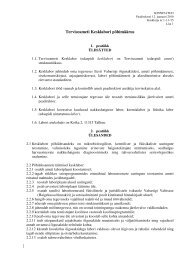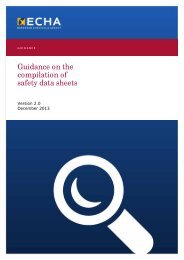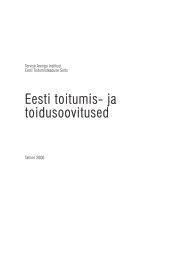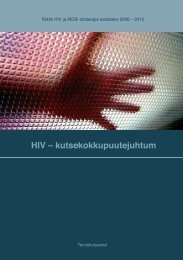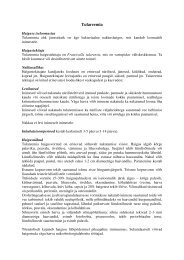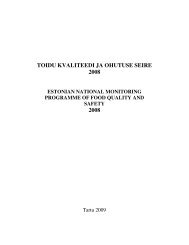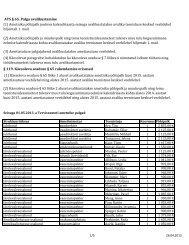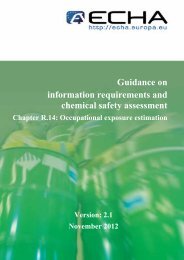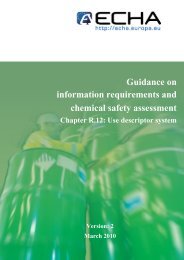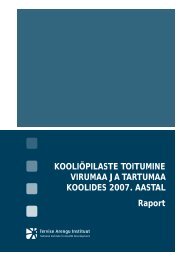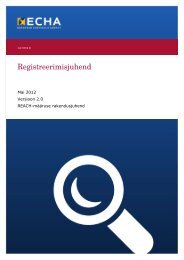Guidance on registration - ECHA - Europa
Guidance on registration - ECHA - Europa
Guidance on registration - ECHA - Europa
You also want an ePaper? Increase the reach of your titles
YUMPU automatically turns print PDFs into web optimized ePapers that Google loves.
46<br />
<str<strong>on</strong>g>Guidance</str<strong>on</strong>g> <strong>on</strong> registrati<strong>on</strong><br />
Versi<strong>on</strong> 2.0 May 2012<br />
2.2.6.4 Calculati<strong>on</strong> of the amount of substance in a mixture or in articles<br />
Specific situati<strong>on</strong>s may occur for substances present in mixtures or in articles:<br />
Amount of a substance in a mixture<br />
In order to be able to calculate the amount of a substance in a mixture, the total volume of the<br />
mixture is multiplied by the fracti<strong>on</strong> of the c<strong>on</strong>stituent substance. This value can, for example,<br />
be obtained from the safety data sheet of the mixture. When <strong>on</strong>ly a range of c<strong>on</strong>centrati<strong>on</strong>s of<br />
a substance in a mixture is available, then the maximum volume of the substance is calculated<br />
using the highest possible c<strong>on</strong>tent of that substance in the mixture. Without more precise<br />
informati<strong>on</strong> <strong>on</strong> the compositi<strong>on</strong>, this may be the <strong>on</strong>ly way to ensure that the registrati<strong>on</strong><br />
requirements are being respected.<br />
Amount of a substance in an article<br />
In the case of articles which c<strong>on</strong>tain a substance that is intended to be released under normal<br />
or reas<strong>on</strong>ably foreseeable c<strong>on</strong>diti<strong>on</strong>s of use, then:<br />
If the weight by weight c<strong>on</strong>tent of that substance is known, then this value is multiplied<br />
by the total mass of the produced and/or imported article; or<br />
If the weight of substance per unit article is known then this value is multiplied by the<br />
total number of imported articles.<br />
More detailed guidance can be found in the <str<strong>on</strong>g>Guidance</str<strong>on</strong>g> for articles.<br />
2.2.6.5 Calculati<strong>on</strong> of the volume for phase-in and n<strong>on</strong> phase-in substances<br />
For the registrati<strong>on</strong>, the registrant must report the volume in t<strong>on</strong>nes he manufactures or<br />
imports per year. REACH defines different methods to determine the t<strong>on</strong>nes per year (Article 3<br />
(30)) depending <strong>on</strong> whether a substance is a phase-in substance or a n<strong>on</strong> phase-in substance.<br />
For the definiti<strong>on</strong> of phase-in substances and n<strong>on</strong> phase-in substances please refer to secti<strong>on</strong>s<br />
2.3.1.1 and 2.3.1.2 respectively.<br />
Calculati<strong>on</strong> of the t<strong>on</strong>nes per year for the registrati<strong>on</strong> of n<strong>on</strong> phase-in substances<br />
The t<strong>on</strong>nes per year of a n<strong>on</strong>-phase-in substance to be reported in a registrati<strong>on</strong> dossier is the<br />
estimated quantity in t<strong>on</strong>nes that is expected to be manufactured and/or imported in the<br />
calendar year (1 January - 31 December) of registrati<strong>on</strong>. In case manufacturing starts <strong>on</strong>ly<br />
later in a particular calendar year, registrati<strong>on</strong> dossiers could cover the expected t<strong>on</strong>nes for a<br />
full calendar year rather than the remaining m<strong>on</strong>ths of the first calendar year, in order to avoid<br />
the need for a very quick update of the registrati<strong>on</strong> dossier for the sec<strong>on</strong>d year.<br />
Calculati<strong>on</strong> of the t<strong>on</strong>nes pe year for the registrati<strong>on</strong> of phase in-substances<br />
In the case of a phase-in substance that has been imported or manufactured for at least three<br />
c<strong>on</strong>secutive years, the t<strong>on</strong>nes per year shall be calculated <strong>on</strong> the basis of the average t<strong>on</strong>nes<br />
manufactured or imported in the three preceding calendar years. If the substance has not been<br />
manufactured or imported for three c<strong>on</strong>secutive years then the t<strong>on</strong>nes manufactured or<br />
imported in a calendar year should be used. This provisi<strong>on</strong> has been put in place to avoid<br />
situati<strong>on</strong>s where a sudden increase in demand would lead to the impossibility to comply with<br />
the registrati<strong>on</strong> obligati<strong>on</strong>s.<br />
Note that in the case of pre-registered phase-in substances the t<strong>on</strong>nes per year determine the<br />
deadline for registrati<strong>on</strong>. Detailed examples <strong>on</strong> how to determine the t<strong>on</strong>nes per year and the<br />
registrati<strong>on</strong> deadline for phase-in substances are provided in secti<strong>on</strong> 2.3.2.<br />
Legal Reference: Article 3 (30)<br />
Annankatu 18, P.O. Box 400, FI-00121 Helsinki, Finland | Tel. +358 9 686180 | Fax +358 9 68618210 | echa.europa.eu


